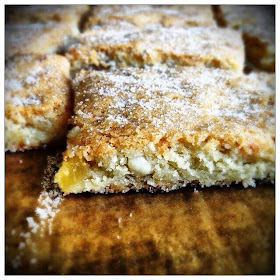Although I regularly use stem ginger preserved in syrup, here I use crystallized ginger which I chop into small little cubes. The smell of the warm, sweet spicy, ginger as these are baking is addictive. Try as I might, I find it impossible not to wolf down one as soon as they come out of the oven and before they have had a chance to cool down.
 It’s hard to describe these biscuits; on one hand they have a slightly
cake-like, chewy texture but they are also reminiscent of shortbread. Quite a
lot of butter is used, but rather than make the biscuits greasy, it imparts the
most wonderful rich buttery taste. Because of the large amount of butter, you
do need to keep an eye on them whilst they are in the oven to ensure that they
do not over-brown as this will only make the end product taste a little bitter.
Remove them from the oven once they are golden brown.
It’s hard to describe these biscuits; on one hand they have a slightly
cake-like, chewy texture but they are also reminiscent of shortbread. Quite a
lot of butter is used, but rather than make the biscuits greasy, it imparts the
most wonderful rich buttery taste. Because of the large amount of butter, you
do need to keep an eye on them whilst they are in the oven to ensure that they
do not over-brown as this will only make the end product taste a little bitter.
Remove them from the oven once they are golden brown.
The inclusion of chopped almonds is only something that I introduced
fairly recently, but I think that the chopped nuts add that something extra and
really make something that looks quite plain into a luxurious tasting treat.
There is very little more that I can say about these biscuits other than
to recommend that you bake some!
Ingredients:
260g plain flour220g caster sugar
125g crystallised ginger, coarsely chopped
75g blanched almonds, coarsely chopped
1 egg
185g butter, melted
To finish:
2tblsp caster sugar, to sprinkle
Method:
 1. Preheat oven to 170C/Fan Oven 150C/Gas Mark 3. Line a 20cm x 30cm
traybake tin with non-stick baking parchment.
1. Preheat oven to 170C/Fan Oven 150C/Gas Mark 3. Line a 20cm x 30cm
traybake tin with non-stick baking parchment.2. Place the flour, caster sugar, chopped ginger and chopped almonds in a large bowl and mix together with a wooden spoon. Add in the beaten egg, followed by the melted butter and mix again to thoroughly combine everything. The mixture will be relatively soft.
3. Press this mixture into the parchment lined tin, smoothing it down evenly
with the back of a metal spoon.
4. Bake in the preheated oven for 30 minutes until golden brown and cooked
through. Remove from the oven and sprinkle with a couple of tablespoons of caster
sugar. Allow to rest in the baking tin for 10 minutes and then remove. Cut into
16 even sized pieces and allow to finish cooling on a wire rack.
Makes 16.


















